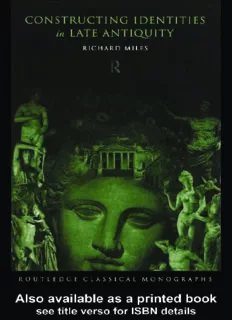
Constructing Identities in Late Antiquity (Routledge classical monographs) PDF
Preview Constructing Identities in Late Antiquity (Routledge classical monographs)
CONSTRUCTING IDENTITIES IN LATE ANTIQUITY CONSTRUCTING IDENTITIES IN LATE ANTIQUITY Edited by Richard Miles London and New York First published 1999 by Routledge 11 New Fetter Lane, London EC4P 4EE Simultaneously published in the USA and Canada by Routledge 29 West 35th Street, New York, NY 10001 Routledge is an imprint of the Taylor and Francis Group This edition published in the Taylor & Francis e-Library, 2002. © 1999 selection and editorial matter Richard Miles; individual contributions, the contributors The right of selection and editorial matter Richard Miles; individual contributions, the contributors to be identified as the Author of this Work has been asserted by him in accordance with the Copyright, Designs and Patents Act 1988 All rights reserved. No part of this book may be reprinted or reproduced or utilised in any form or by any electronic, mechanical, or other means, now known or hereafter invented, including photocopying and recording, or in any information storage or retrieval system, without permission in writing from the publishers. British Library Cataloguing in Publication Data A catalogue record for this book is available from the British Library Library of Congress Cataloging in Publication Data Constructing identities in late antiquity/edited by Richard Miles. p. cm. Includes bibliographical references and index. 1. Civilization, Classical. 2. Rome—Cultural policy. 3. Identity in literature. 4. Christianity—Rome— Influence. 5. Rome—History—Germanic Invasions, 3rd–6th centuries. I. Miles, Richard, 1969– DG78.C585 1999 937–dc21 98–37614 CIP ISBN 0-415-19406-7 (Print Edition) ISBN 0-203-01617-3 Master e-book ISBN ISBN 0-203-20286-4 (Glassbook Format) CONTENTS Acknowledgements vii List of figures viii Notes on contributors ix 1 Introduction: constructing identities in late antiquity 1 RICHARD MILES 2 The writes of passage: cultural initiation in Heliodorus’ Aethiopica 16 TIM WHITMARSH 3 Gender and identity in Musaeus’ Hero and Leander 41 HELEN MORALES 4 Prudentius’ Psychomachia: the Christian arena and the politics of display 70 PAULA JAMES 5 Dramatic identities: tragedy in late antiquity 95 PAT EASTERLING AND RICHARD MILES 6 Translate into Greek: Porphyry of Tyre on the new barbarians 112 GILLIAN CLARK 7 Autobiographical identity and philosophical past in Augustine’s dialogue De Libero Arbitrio 133 SIMON HARRISON 8 The destruction of statues in late antiquity 159 PETER STEWART v CONTENTS 9 Women and learning: gender and identity in scenes of intellectual life on late Roman sarcophagi 190 JANET HUSKINSON 10 Constructing the judge: judicial accountability and the culture of criticism in late antiquity 214 JILL HARRIES 11 The barbarian in late antiquity: image, reality, and transformation 234 PETER HEATHER Index 259 vi LIST OF FIGURES 8.1 Statue of a late Roman emperor at Barletta 171 8.2 De Rossi’s drawings of paintings in the anonymous hypogeum of the Via Paisiello, Rome 174 8.3 Painting of the destruction of an idol from the Via Paisiello hypogeum 176 8.4 Marble head of Mithras from the Walbrook Mithraeum in London 178 9.1 ‘Married couple’ with Muses, c. AD 260 194 9.2 Front of sarcophagus showing young man as the ninth Muse, late third century 196 9.3 Sarcophagus, c. AD 280 198 9.4 Front of a sarcophagus, late third century 201 9.5 Sarcophagus (?) panel, late third or early fourth century 204 9.6 Fragment of a sarcophagus. Early fourth century 206 vii NOTES ON CONTRIBUTORS Gillian Clark is a Senior Lecturer in Classics at the University of Liverpool. Pat Easterling is Professor of Ancient Greek at the University of Cambridge and a Fellow of Newnham College. Jill Harries is Professor of Ancient History at the University of St Andrews. Simon Harrison is a Research Fellow at St John’s College, Cambridge. Peter Heather is a Reader in History at University College, London. Janet Huskinson is a Lecturer in Classical Studies at the Open University. Paula James is a Lecturer in Classical Studies at the Open University. Richard Miles is a Research Fellow at the Open University and a Teaching By-Fellow at Churchill College, Cambridge. Helen Morales is a Lecturer in Classics at the University of Reading. Peter Stewart is a Lecturer in Classics at the University of Reading. Tim Whitmarsh is a Research Fellow at St John’s College, Cambridge. viii ACKNOWLEDGEMENTS The editor would like to thank all those who attended the two-day colloquium at the Open University, Milton Keynes, where the individual papers were discussed. Their contributions undoubtedly improved all aspects of this volume. Particular thanks are due to our excellent chairpersons, Kate Cooper and Christopher Kelly, who through inspired interventions and careful diplomacy kept the discussion flowing. The Faculty of Arts Research committee of the Open University very generously met the cost of the two days. Thanks are also due to Richard Stoneman for his initial encouragement and Kate Chenevix Trench for seeing the book successfully through the publication process. Undoubtedly, the editor’s greatest debt is to Janet Huskinson, without whose hard work, encouragement and good humour this project would not have come to fruition. ix
Description: